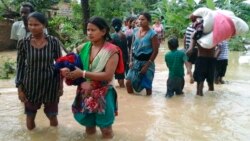The U.S. Mission in Nepal, through the U.S. Agency for International Development, or USAID, has announced three new programs with up to $70 million in funds that will help communities more quickly recover from natural disasters and other stressors.
The announcement came at a Resilience Summit organized in Kathmandu. The Summit brought together government officials and development experts to look for new models to solve complex and interrelated challenges such as extreme poverty, food security, and climate shocks. Working under the leadership of the Government of Nepal, the U.S. Government aims to save and improve more lives, build inclusive economic growth, and decrease the need for humanitarian assistance.
Speaking at the Summit, U.S. Ambassador Peter Bodde, shared this message: “Resilience is essential if we are to win the fight against poverty. We know we cannot prevent floods and landslides, but we can work much harder and more strategically to ensure these shocks don’t devastate families or set back hard-won development gains.”
Chief Guest Vice Chair of National Planning Commission Dr. Govinda Pokhrel, said, “The Government of Nepal sees resilience as a vital framework to help alleviate poverty and promote more sustainable development, lessening the impacts of disasters. That will take creativity, innovation, and cross-sectorial partnerships, and we are pleased that USAID is highlighting this most important priority.”
The three USAID Resilience Projects include an up to $70 million Community Resilience Program integrating disaster risk reduction and climate change adaptation into USAID’s food and nutrition security efforts in Nepal; a $500,000 Innovative Early Warning Flooding System funded by USAID’s Office of Foreign Disaster Assistance to help protect communities in the Eastern region from flooding; and a $100,000 Science and Technology Competition for Resilience – a call for bold and innovative solutions to “building sustainable food security” in Nepal.
The competition announced at the Summit calls upon innovative problem solver individuals, non-profits, academic institutions, and the private sector, with a focus on districts primarily in the Mid-and Far-West regions of the country.
When confronted with events like floods, earthquakes, climate change or changing disease patterns, people should be able to take effective action to avoid major losses and preserve their abilities to rebound and get back on track. That is why the United States is working with its partner Nepal today to meet the challenges of tomorrow.


















